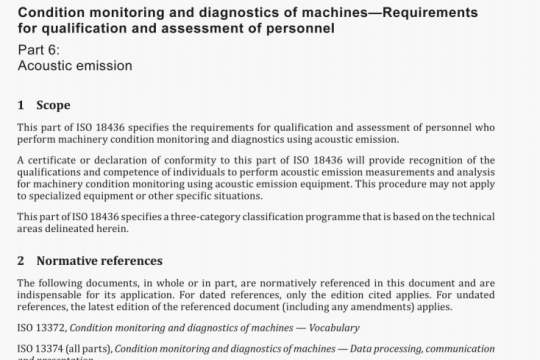BS EN ISO 20795-2:2013 pdf free
BS EN ISO 20795-2:2013 pdf free.Dentistry一Base polymers一Orthodontic base polymers
At least 24 h from the beginning of the curing cycle, wet-grind or machine the plates (8.4.1.1) in a milling machine (8.3.2.2.2), equally from both mould surfaces, to obtain flat, parallel surfaces, and so that the thickness of the plates remain slightly oversized. Take care to avoid overheating the specimens.
Cut each plate breadthwise with a cutting device (8.4.2.2) in equal specimen strips 8 mm wide, so that the dimensions remain slightly oversized compared with the finished specimen strips. Wet-grind all surfaces smooth and flat with the metallographic grinding papers (8.3.2.2.3) to the required dimensions,length 39 mm, height, ht, (8,0±0,2) mm, and width, bt, (4,0±0,2) mm, using grain size 18 μm (P1000) or 15 μm (P1200).
Fix the specimens lengthwise in the holding device (8.4.2.3) and set a mark exactly on the centreline midway from the edges of the specimens. Cut the pre-crack with a diamond blade and a saw (8.4.2.2) to a depth of (3,0±0,2) mm along the marked centreline.
Fix one specimen at a time, in a clamp or holding device (8.4.2.3) so that the specimen cannot be removed by hand/machine force. Wet the pre-crack with a drop of glycerol (8.4.1.2). Set the sharp blade (8.4.2.4) on the bottom of the pre-crack and cut the sharp notch with hand/ machine pressure and a sliding back and forth motion.
A notch depth in the range of 100 um to 400 μum is sufficient. Use an optical microscope (8.4.2.5) to check the crack depth. It is recommended to test the cutting procedure on a pre-test specimen. Attempting to further increase the notch depth should not be done. The situation of the notch arrangement is shown in Figure 2 a). Measure the width, bt, and the height, ht, of the specimen with a micrometer (8.3.2.2.4).
NOTE Before fracture toughness testing, ink can be introduced into the notch and allowed to dry to improve identification of the complete notched area.
Determine the total crack length, a, as the average of three measurements (a1, a2, and a3) of the distance between the specimen surface and the area fractured in the test. Take these three measurements along the quarter-and half-width lines (see Figure 3).BS EN ISO 20795-2 pdf free download.




